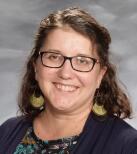

by Angela Faulhaber, Middle School and High School Instructional Coach
West Clermont Schools
Innovative Teaching About the Little Things
I walked into a sixth-grade classroom the other day and couldn’t find the teacher. She was in the middle of the room, squatting next to a cluster of desks, conferring with students about their writing. She blended right in. In the room across the hall, 10 students gathered around a small table while the teacher helped them solve a math equation and the rest of the class worked independently.
When we talk about innovation in schools, it’s often these quiet moments that have the biggest impact on students. Innovation doesn’t have to be flashy or technology-driven. In fact, in both of the examples above, there was no tech used at all. Students write in their spiral notebooks and solve equations on small dry erase boards.
In my work as an instructional coach with West Clermont Schools, I work alongside amazing teachers as they reflect on their practice and implement new ways to support student achievement. Currently, we are investigating innovative ways to make classrooms feel smaller in order to support students across a wide range of abilities.
SMALL GROUPS FOR BIG LEARNING
Small group teaching is no flavor of the month – it is a time-tested method for elementary teachers. It involves pulling small groups of students together to reteach or enrich in a very focused way.
The idea of it in secondary schools, though, is an innovative practice. The middle school has gained new data analysis tools this year that make this approach more accessible for educators and it has been inspiring to watch teachers explore the possibilities.
The results of small group teaching are undeniable. In a meta-study, researchers at the National Board for Economic Research found, “…[S]small-group instructional programming by teachers, paraprofessionals, volunteers, or parents—is one of the most versatile and potentially transformative educational tools in use today.”
I’ve seen evidence of its effectiveness in our own classrooms as well.
“What do you like about small groups?” I asked the sixth-grade students sitting next to me.
“I like that I don’t have to work on things I don’t understand,” Madison* said. The child next to her nodded and added, “I like that I get to talk to the teacher and can ask questions.”
Students report that they feel seen, known, and connected.
NON-PERMANENT WRITING SURFACES
Small moves with big impact are happening with high school students too. On a Tuesday afternoon in late January, students in an Algebra I class followed along while their teacher reviewed for a test. Instead of talking to the whole class for the whole bell, this teacher had students pivot to working with a small cluster of three students.
The innovative practice? Each group had a set of tasks to work on. Rather than working on their computer, or even with paper, though, they were encouraged to write on the desks with dry erase markers. The conversation around their thinking was elevated and focused. Students were collaborative, helping each other, correcting others.
Inviting students to write on non-permanent surfaces comes from Building a Thinking Classroom by Peter Liljedahl, the focus of a teacher book study with Math Instructional Coach Mike Ross. This text focuses on small moves that are easily implemented and that research shows have a big impact on student learning.
According to Liljedahl, when students work on a non-permanent surface, “…they can quickly erase any errors, which, for them, reduces the risk of trying something.” It also allows teachers to circulate around the room and give specific, actionable feedback in a constructive way.
Teachers are experimenting with using non-traditional writing surfaces – anything from shower curtains to using window markers – to create space for students to take risks and become more critical thinkers.
MINDSET SHIFTS
These types of innovative, small moves are happening across the district, across grade levels and content areas as teachers reflect on the best ways to support students. According to George Couros, author of The Innovator’s Mindset, “innovation isn’t about the stuff; it is a way of thinking.”
Many of us think about sweeping changes or big projects when we think about innovation. And sometimes that’s true. But what’s also true is that these moves educators are making – incorporating more small group instruction and using non-permanent writing surfaces – are part of a mindset shift. These are the everyday innovations that are driving students to the horizon of success.




